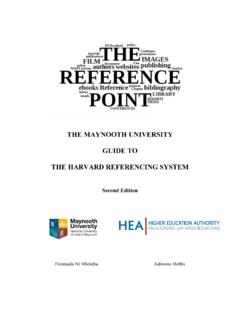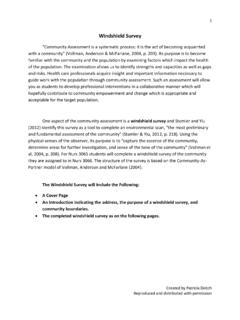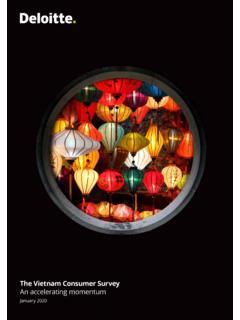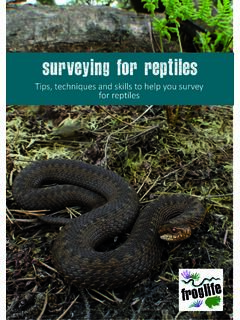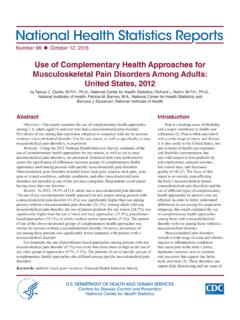Transcription of Social Media Survey - Maynooth University
1 Department of Sociology Time Well Spent? A Survey of student online Media usage Patricia Kettle, Niall Gilmartin, Mary P. Corcoran, Delma Byrne and TianHang Sun Department of Sociology, Maynooth University December 2016 2 Table of Contents Foreword .. 3 Acknowledgements .. 4 Executive Summary .. 5 List of Figures .. 6 Context: Digital Natives and the New Media .. 7 Methodology .. 9 Access, time spent and connectedness to the Library and the Department .. 10 Primary use of Social Media by Use of Social Media for academic Smart phone as a pedagogical tool?..17 Levels of Online Knowledge and Competency .. 19 Switched On or Switched Off? .. 21 Conclusion .. 24 Bibliography .. 25 Appendix (copy of the questionnaire)..28 3 Foreword In the academic year 2015-2016 the Department of Sociology undertook research on the Social Media usage of the First Year undergraduate student cohort.
2 The objective was to acquire a better sense of how students access and use Social Media during an average college day, and assess the extent to which Social Media enhances or impacts on student s learning experiences. This report provides a valuable and comprehensive insight into University students online Media use. Moreover, its findings serve as a useful stimulus for developing new pedagogic strategies and innovative learning tools to facilitate and deliver learning. The report complements the Department of Sociology s earlier study, Bringing the students back in: a study of first year experience and retention 2013-14, and data gathered by the Office of the Vice President for Strategy and Quality s Annual Incoming Student Survey (2014). The findings in this report are timely and are of critical relevance as the University navigates the first year of implementation of the Curriculum Initiative.
3 Undertaking this piece of research proved an important reflective exercise for the Department of Sociology, and indeed for our cohort of first year students. We highly recommend that other Departments consider carrying out similar (periodic) reviews of this nature as a way of staying in tune with the student body, and for the purpose of building an archive of data on student learning and experiences at Maynooth University , which can inform pedagogical practices and future curriculum development. 4 Acknowledgements The research instrument was constructed and designed by Professor Mary P. Corcoran, Dr. Patricia Kettle and Dr. Niall Gilmartin relying largely on the publicly available Survey tools made available through the EU Kids Online Network Survey (2014).
4 We received excellent advice and feedback on the Survey instrument from Dr. Delma Byrne, Dr. Brian Conway and Dr. Aphra Kerr. The data was gathered by the Department s team of first year tutors to whom we are very grateful: Nigel Connor, Caitriona Fitzgerald, Dr. Kerry Gallagher, Patrick Gallagher, Dr. Adrian Millar and Crist n O Rourke. Data gathering on the Kilkenny campus was overseen by Ms. Stephanie McDermott. Ms. Tianhang Sun, a sophomore student at Boston College who interned at the Department of Sociology under the mentorship of Dr. Delma Byrne took responsibility for most of the data entry and for the data processing. Maeve Corcoran White also contributed to data entry. We would like to thank the Sociology students on the Maynooth and Kilkenny campuses who took part in the project. Finally, we are grateful to Professor Aidan Mulkeen, Vice President and Registrar of Maynooth University for officially launching this report.
5 5 Executive Summary Levels of online usage have accelerated dramatically over the course of the last ten years, particularly with the advent of the smart phone. For a significant proportion of the population, vast tracts of their working and Social lives are now mediated and governed by digital technology. For many of those now entering University , the notion of a world without Instagram, Snapchat, WhatsApp and a host of other digital platforms and applications is simply unthinkable. As online usage and digital technology continue to saturate our working and Social worlds, they present both challenges and opportunities for the formal education system. The unprecedented access to online content offers undergraduate students the opportunity to engage with unlimited academic resources.
6 Equally, digital technology can also be a distraction for students from their college work and study. Moreover, the widespread use of hand-held devices can be viewed as a disruptive and intrusive presence in lecture halls and classrooms. Despite the widespread prevalence of Social Media use and smart phones within Irish universities, we have not had until now rigorous data examining the extent and levels of usage among University students. This report provides a comprehensive snapshot of Social Media use and the type of content undergraduate students are accessing. Key findings include: High levels of online usage on a daily basis, with the majority of respondents accessing online content through smart phones throughout a typical college day. More than 60% of students are spending four hours or more on Social Media a day.
7 Levels of usage and types of content accessed mirror international trends. Facebook, Instagram, YouTube and Spotify are the most popular internet platforms accessed regularly. The majority of time spent on Social Media during an ordinary college day is for Social rather than educational purposes. Respondents report very low levels of civic and political engagement through Social Media . Only a minority (23%) read or watch current affairs or news programmes on a daily basis. There is an emergent pattern of students using Social Media and the internet as an academic research tool and platform for communication among their peers. Although Moodle remains an important tool for students, in the main students do not use it as a platform of communication, debate or discussion on issues pertinent to the modules that it supports.
8 Peer to peer communication seems to mainly occur through instant messaging. Respondents are digitally literate and report high levels of competency, proficiency and knowledge about digital technology and online content. A significant proportion of students (over 55 per cent) report feeling bothered if they cannot check smartphones while in class. A third of students who responded to the Survey report that they have spent less time that they should on college work because of the time spent on devices. About one third also believe that this has resulted in them falling behind in college work. Overall a significant majority of students (86%) are of the view that Social Media has helped them socially, with a slightly lower majority (70%) of the view that it has helped them academically. 6 List of Figures Figure 1.
9 Respondents by Age .. 9 Figure 2. Time spent on Social Media on average college day .. 10 Figure 3 Social Media connect with library ..11 Figure 4. Social Media connect with Dept of Sociology .. 11 Figure 5. Comparison of Social Media connect with library and Department .. 12 Figure 6. Connect to the Department of Sociology, Twitter and shareable content .. 13 Figure 7 Usage of Social Media daily .. 13 Figure. 8. Participation on a political site ..15 Figure 9. Particpation on a civic 15 Figure 10. Social Media use for academic purposes ..16 Figure 11. Use of Social Media for learning Figure 12. How often have you downloaded free apps ..18 Figure often have you paid for downloads for educational purposes .. 18 Figure often have you used an academic search engine .. 18 Figure 15. Instant messaging to communicate with other students.
10 19 Figure 16. Reliability of information on a Figure 17. Bookmark 20 Figure 18. Moodle to follow module.. 21 Figure 19. Device 22 Figure 20. Devices and time management .. 22 Figure 21. Impact of time spent on devices on college work .. 23 Figure 22. Regulating usage .. 23 7 Context: Digital Natives and the New Media Sociological research on digital technology falls broadly into two fields, one examining the political economy of new Media and debates regarding power and control, and the other, exploring the impact of technology on education. The meaning of Social Media is highly contested: some use the term quite narrowly referring to one-on-one communications through a medium such as Facebook while others use the term to refer to all aspects of Web sites (Hunsinger and Senft 2015).

